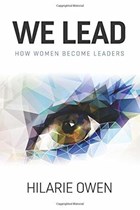- Leadership
How Women Leaders Reach the Top
New guidebook draws on the experience of 30 high-achieving women leaders to show the way
Theresa May’s ill-fated premiership is perhaps another example of the ‘glass cliff’– the phenomenon where women are likelier than men to attain senior leadership roles during periods of crisis, when the chance of failure is highest. Undoubtedly, her otherwise successful career reminds us how few women ever reach the top in politics or business, even in 2019.

In her new book, We Lead: How Women Become Leaders, Hilarie Owen quotes Dr Martin Luther King Jnr “…human progress is neither automatic nor inevitable; it requires the tireless exertions and passionate concern of dedicated individuals.”
Over the past decades very many dedicated individuals have striven to promote female leadership. Much has been achieved and the prejudices that existed in earlier generations have greatly reduced. But, although the sons and daughters of the 1960s feminist generation now occupy leadership positions in business and politics, gender parity is still some way off in the echelons of senior leadership.
While more women than men are now graduating from university and women are entering professional and managerial ranks at the same rate as men there is an imbalance at the top, with too few women attaining senior roles. Cranfield School of Management’s Female FTSE Board Report 2018, showed just 6.4% of FTSE 250 executive directors were women (along with 29% of non-executive directors). Recent elections have improved the position in the UK parliament but still only 32% of MPs are women. Clearly, able, highly qualified, women are not reaching the top with all the loss of talent that implies. So, what is going wrong?
Hilarie Owen approaches the issue of what’s going wrong in reverse. She asks what is going right for the many women who have reached the top? And uses the experience of 30 high-achieving executives, entrepreneurs, and politicians to illustrate her themes. Building on lessons and insights from these 30 role models, she draws on the latest academic thinking on leadership, combined with her own research and experience, to provide a nine-step guide for women who aspire to senior roles and to realizing their full leadership potential.
Leadership is not something easily picked up on a course or that arrives by osmosis once you become a manager. It is a lifelong journey that involves self-awareness, self-belief, overcoming doubt, building confidence, developing a personal identity and a purposeful mindset. On these foundations effective leaders also need to combine decision-making and negotiating skills, and to underpin these with authenticity, integrity, trustworthiness, resilience and courage. These are all universal qualities, though perhaps acquired and developed from a different perspective by women than by men.
Owen asserts that leaders are neither born nor made but must create themselves. Her analysis of how 30 women came into and experienced senior leadership and how they navigated the dynamics of power and influence, career and family, provides a valuable backdrop to a book that is essentially a practical guide to executive career progression and a compelling explanation of how women can unleash their full potential as leaders and encourage a culture of gender parity in their organizations.
………………………………………………………………………………………………………………..................
Hilarie Owen works as a mentor of senior directors and top teams. She has worked for global companies and two government departments, as well as with the RAF Red Arrows and Harvard University and has resolved leadership challenges in many different countries.
‘We Lead: How Women Become Leaders’, Hilarie Owen, published by Novaro Publishing, 2019, ISBN: 978-1-9998329-4-0
ARTICLES YOU MIGHT LIKE
RESEARCH
Why organizational resilience requires adaptive leadership particularly in times of crisis
DEVELOPING LEADERS QUARTERLY MAGAZINE AND WEEKLY BRIEFING EMAILS

































